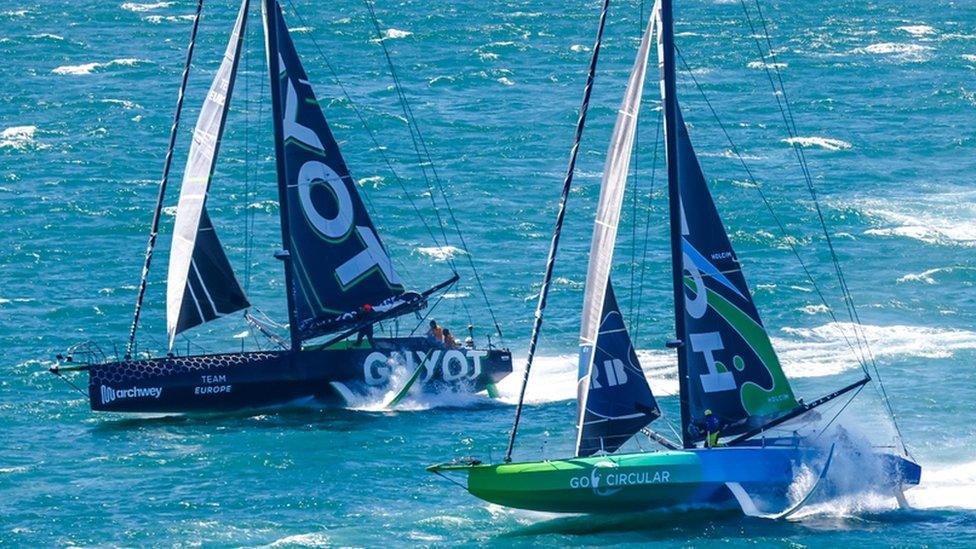Microplastics found in ocean samples across the world
- Published
- comments

Sailors in the Ocean Race are taking sea water samples along the way to measure data on the concentration of microplastics, oxygen saturation and water temperature
Microplastics have been found in every sample of sea water collected by sailors competing in a race around the world's oceans.
During the Ocean Race competitors sail in some of the most remote parts of our seas, but not even these areas have escaped from plastic pollution.
The level of microplastics found in the most recent samples were 18 times higher than the samples taken during the previous Ocean Race that ended in 2018.
But what are microplastics and why does this matter? Keep reading to find out.
What are microplastics?
By looking closely at samples of water, scientists can discover what plastic has been left behind
When larger pieces of plastic such as drinks bottles break down, they can turn into smaller pieces. Anything smaller than 5mm is called a microplastic - so glitter counts as a microplastic.
You do get some pieces that are even smaller - called nanoplastics. These are pieces of plastic that we can't see with the human eye.
Nanoplastics pollute the environment and create health problems for animals, because they can easily be ingested.
Last year it was discovered that rare seabirds have been eating glitter and other microplastics found in the sea.
How do you measure the levels of microplastics?
Stefan Raimund, science lead for The Ocean Race, said: "The data we gather can help inform and influence business and governments" to better protect our planet
During the Ocean Race, the sailors' boats automatically collected some of the sea water to test.
A filter was used that picked up plastic particles measuring between 0.03mm and 5mm.
Forty five samples were collected during the first few legs of the race when the boats travelled from Cabo Verde to South Africa to Brazil.
The highest concentrations of microplastics were found near coastal and urban areas, as well as when travelling through so-called "garbage patch" areas of the sea.
WATCH: Martin finds out why plastic is a problem (Pictures from Greenpeace, Caroline Power and Blue Planet II/Â鶹ԼÅÄ iPlayer)
However, an increasing amount of microplastics were also found in Point Nemo, the part of the ocean that is furthest from land and the most remote place on the planet.
In that area 320 microplastic particles per cubic metre were measured compared with 9-41 in 2018.
Scientists say the higher concentrations might also be due to their equipment being much more sensitive than when microplastic concentrations were measured in 2018.
Each year, 400 million tonnes of plastic is produced and 40% of that is single-use plastic only used once before it is thrown away
Victoria Fulfer, a visiting scientist from the University of Rhode Island at NOC, said: "It's really concerning that we are finding microplastics in every sample, from coastal areas to the most remote regions of the ocean.
"Over half of our samples so far have more than 500 microplastic particles per cubic metre that are larger than 0.1 mm, and those concentrations only get higher when we look at even smaller particles."
What's being done about plastic pollution?
Mounds of wet wipes which contain plastic are reshaping the River Thames
In March 2022, nearly 200 UN countries agreed to start negotiations about an international plan for how to deal with plastic waste.
World leaders have until 2024 to agree the plastic pollution treaty - setting rules on how plastic is made, used and thrown away - and how the treaty could be paid for.
The UN Environment Programme (Unep) aims to bring countries together to work on big issues affecting the planet.
claims plastic pollution could be reduced by 80% with a few big changes.
WATCH: What are the hardest products to recycle, and why?
The report says countries around the world need to make a circular economy. This means that plastic is kept in circulation and used for as long as possible.
It found the biggest reduction in plastic waste - about a 30% reduction - could be achieved by reusing the plastic we already have.
That means promoting ideas like refillable water bottles and deposit return schemes that encourage people to return their plastic products in exchange for cash.
- Published30 November 2015
- Published26 June 2020
- Published11 May 2023
